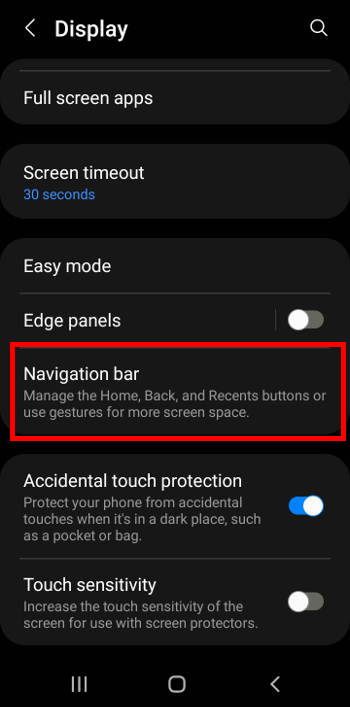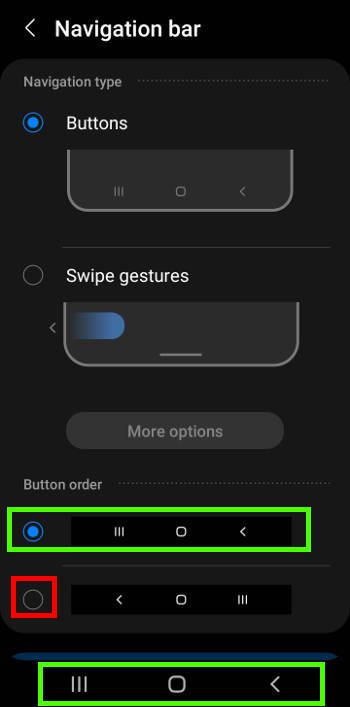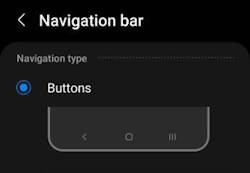
Galaxy S23 navigation buttons (and the navigation bar) are still the default navigation option. Of course, you can switch to navigation gestures at any time.
This Galaxy S23 how-to guide explains the meaning of Galaxy S23 navigation buttons, their usage, and the customization of the navigation bar on Galaxy S23.
Although Galaxy S23, S23+, and S23 Ultra are substantially different, the navigation settings are identical on all three models. So, this guide applies to all of the Galaxy S23 models. On Galaxy S23 and many other Galaxy phones, you can also choose to use navigation gestures.
Table of Contents
- Galaxy S23 navigation buttons and navigation bar
- Functions and usage of Galaxy S23 navigation buttons
- How to customize the layout (sequence) of Galaxy S23 navigation buttons?
- How to further customize Galaxy S23 navigation buttons and Galaxy S23 navigation bar?
- Galaxy S23 Navigation buttons vs. Navigation gestures: which is for you?
- How to show Galaxy S23 navigation buttons when in full-screen mode?
Galaxy S23 navigation buttons and navigation bar
If you just switched from other Android phones to Galaxy S23, you may be surprised by the navigation buttons. Of course, you can easily switch to navigation gestures after the initial setup.
Galaxy S23 navigation buttons refer to the three buttons at the bottom of the screen, as shown in the screenshot below.
- Home button.
- Back button.
- Recents (multiwindow) button.

The bottom area hosting the three navigation buttons is called the Galaxy S23 navigation bar. FYI, the top of the screen with some icons is named as the Galaxy S23 status bar,
Many Samsung Galaxy phone owners still prefer navigation buttons over navigation gestures, especially for many older generations. Most of them also get used to and are comfortable with the 3-button navigation.
Therefore, Samsung offers navigation buttons as the default option in Galaxy S23. This guide explains when to use Galaxy S23 navigation buttons and when to use Galaxy S23 navigation gestures.
Please note you can switch the location of the Back and Recents button (read on). But you cannot change the location of the Home button. It is always in the middle.
With Samsung’s NavStar (Good Lock), you can even customize the icons of Galaxy S23 navigation buttons and add more buttons to the navigation bar (read on).
The accessibility button (e.g., Accessibility shortcut, Extra Dim shortcut), if enabled, also appears on the navigation bar, as shown in the screenshot below.

When using the keyboard, you can also choose to show a keyboard button, as explained here. The screenshot below shows the keyboard button, together with Galaxy S23 navigation buttons.

You can tap the keyboard button to get more options, including disabling the keyboard button, as shown in the screenshot below.
In addition, you have the option to quickly switch the keyboard installed on the Galaxy S23.
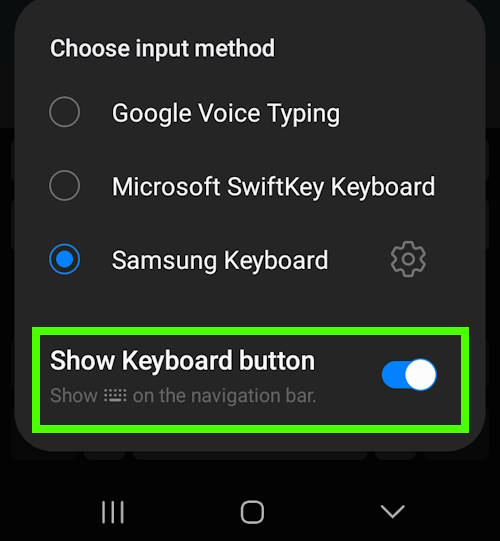
Functions and usage of Galaxy S23 navigation buttons
Let’s now explore the functions and usage of three Galaxy S23 navigation buttons.
1. Home button
The main function of the Home button is to “reset” your view to the Home screen.
You can tap the Home button to return to the Galaxy S23 home screen immediately from any app or any screen. If you are already on one of the Galaxy S23 Home screen panels/pages, then tapping the Home button would bring you to the Home panel of the Home screen.
Tapping the Home button does NOT close the app you are using. Instead, the app is pushed to the background. The behaviour of apps in the background depends on the developer’s implementation.
You may also tap and hold (long tap) the Home button to launch the voice assistant. By default, it is Google Assistant on Galaxy S23, as shown in the screenshot below.
Update: after updating your Galaxy S23 to One UI 6.1, you will access Circle to Search feature if you tap and hold on the Home button.
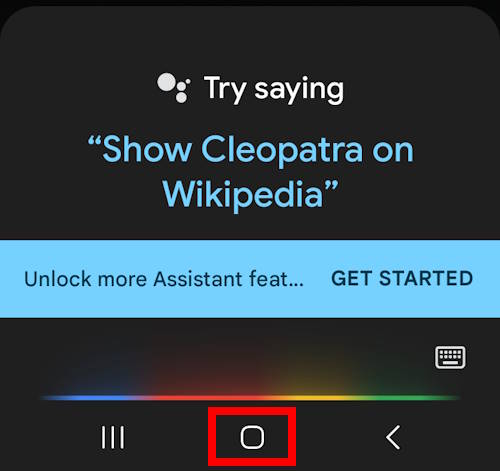
2. Back button
The function of the Back button is to return to the “previous” screen within an app.
So, if you keep tapping the Back button, Galaxy S23 should exit that app and eventually return to the Galaxy S23 Home screen.
Some apps do not support the “previous” screen. In this case, if you tap the Back button, Galaxy S23 will close the app and return to the Galaxy S23 Home screen.
When you exit an app with the Back button, Galaxy S23 normally closes the app gracefully. But if you exit the app with the Home button, the app is only pushed to the background. For some apps, the result can be slightly different.
As mentioned, there is no navigation bar or Galaxy S23 navigation buttons on the Galaxy S23 lock screen. But the Back button appears when you are on the unlock screen (i.e., typing the password/PIN) and on the Dynamic lock screen.
3. Recents button
The Galaxy S23 Recents button is sometimes referred to as the “Multiwindow” button because it is related to the multiwindow feature on Galaxy S23. You can use it to launch apps in the split-screen view mode or pop-up view mode in Galaxy S23. Since the Android 13 (One UI 5) update for Galaxy S22, S21, and S20, you can also use gestures to launch apps in the multiwindow mode.
In the stock Android, the corresponding navigation button is usually called the Overview button.
The main functions of the Galaxy S23 Recents button are:
- To manage previously opened apps in the Recents screen. You can re-open or close any of them or check detailed info on the app.
- To launch apps in the multiwindow mode (split-screen view or pop-up view).
- To quickly switch to previously opened apps. You can use the Recents button to quickly switch between the last two opened apps. On the Recents screen, you can switch to any of the previously opened apps.
You can use two gestures on the Galaxy S23 Recents button:
- Tap the Recents button once to access the Galaxy S23 Recents screen (list of recently used apps), as shown in the screenshot below.
- Tap the Recents button twice (double tap) to switch to the last opened app. This gesture switches between the last two previously used apps on the Recents screen. If you need to switch to other opened apps, you must use the thumbnail of the corresponding app in the Recents screen.
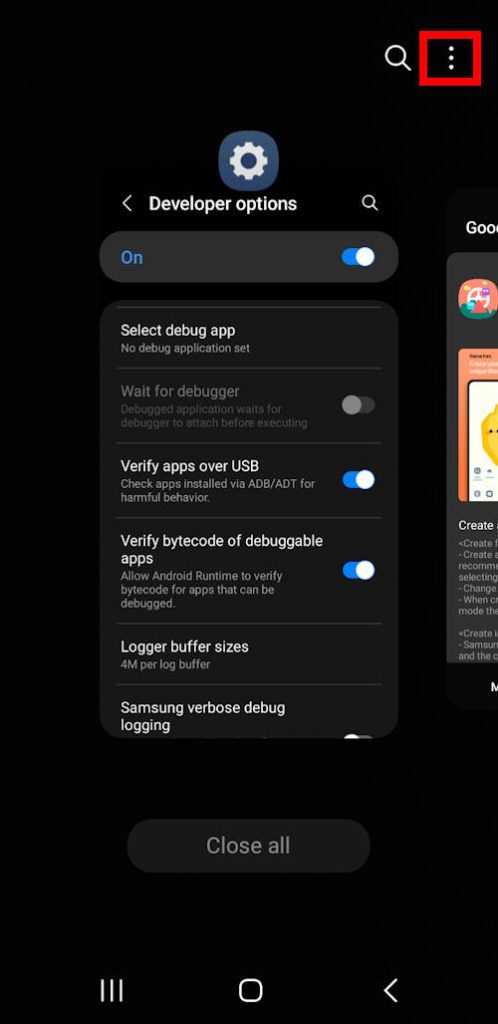
If you open the camera app (or other apps) on the lock screen (without unlocking the phone, the Back button (and Home button) is always available. But the Recents button is always hidden.
Besides, on the Galaxy S23 Recents screen, there is a menu button (3 vertical dots), right to the universal search icon, as shown in the screenshot above. You can tap the menu icon, then tap settings to enable/disable recommended apps, as shown in the screenshot below.
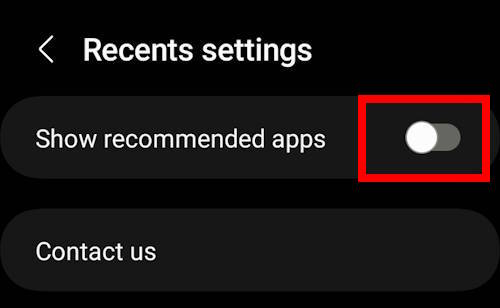
After enabling the Show recommended apps, you will see some “recommended” apps that Galaxy S23 guesses you will likely use them, as shown in the screenshot below. These app icons are shown immediately above the Galaxy S23 navigation bar.
This is just an AI feature of Galaxy S23 (in One UI 5.1). The system predicts what you will likely use, based on your usage history.
For example, in the screenshot, Galaxy S23 predicted I would likely use Chrome, Google Keep, Play Store, or Samsung Notes.
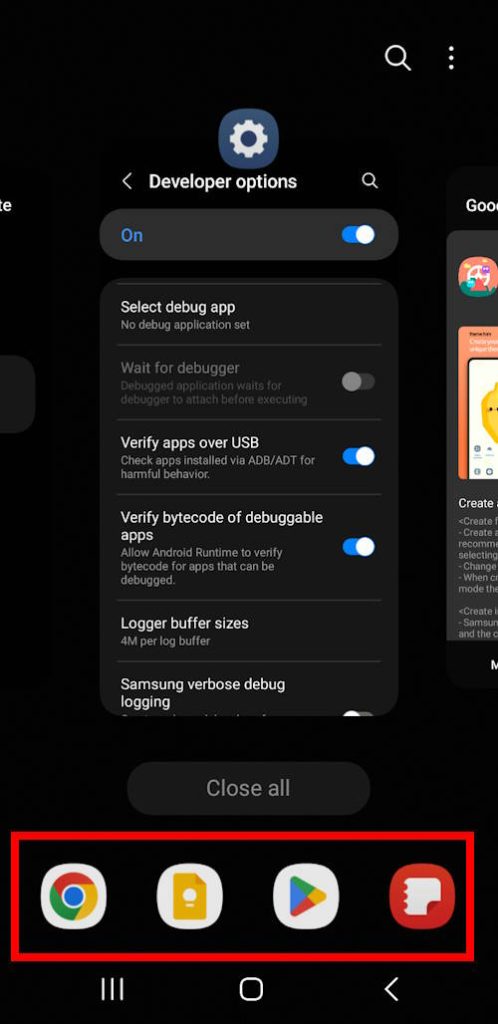
How to customize the layout (sequence) of Galaxy S23 navigation buttons?
On Galaxy S23, the Recents button is on the left of the Home button, and the Back button is on the right, which is the opposite of the button layout in old stock Android.
So, if you switched to Galaxy S23 from a non-Samsung Android phone, you may tap the wrong buttons frequently.
You can follow the steps below to customize the layout of Galaxy S23 navigation buttons to match that in other non-Samsung Android phones.
Step 1: Open Galaxy S23 Settings
Galaxy S23 Settings can be accessed in different ways. For example,
- Tap the Settings app icon on the Galaxy S23 Home screen or Apps screen.
- Tap the gear icon in Galaxy S23 quick panel.
Besides, you can use voice commands (Google Assistant or Bixby) to open Galaxy S23 Settings.
Step 2: Access Galaxy S23 display settings
On the Galaxy S23 Settings page, as shown in the screenshot below, tap Display.
Step 3: Customize the order of Galaxy S23 navigation buttons
On the Galaxy S23 Display settings page, you can tweak a lot of settings and options related to the UI on Galaxy S23.
Among them, you can find and tap the Navigation bar, as shown in the screenshot above, to customize the Galaxy S23 navigation bar.
In the Navigation bar settings page, as shown in the screenshot below, you can:
- Choose to use between navigation buttons and navigation gestures.
- Customize the navigation button order.
For example, as shown in the screenshot, the default button order is used.
You can tap the alternative layout, as shown below.
Step 4: Verify the new navigation button layout in the Galaxy S23 navigation bar
Once you tap the button for the new button order, you should immediately see the change in the Galaxy S23 navigation bar, as shown in the screenshot above.
How to further customize Galaxy S23 navigation buttons and Galaxy S23 navigation bar?
Samsung removed most of the navigation bar customizations (e.g., as in Galaxy S8) when One UI was introduced. On Galaxy S23, by default, you can only customize the button layout, as discussed above.
If you want to customize the icon of the Galaxy S23 navigation buttons, customize the Galaxy S23 navigation bar (e.g., the background colour of the navigation bar), or add more buttons to the Galaxy S23 navigation bar, you can use the official Samsung Good Lock app (NavStar), as explained in detail in this guide. Although the guide was written for Galaxy S21, it works for Galaxy S22 and S23 as well.
If you switched to Galaxy S23 navigation gestures, you can check this guide on how to use NavStar to customize navigation gestures on Galaxy S23.
Galaxy S23 Navigation buttons vs. Navigation gestures: which is for you?
It is always arguable when we try to prove navigation buttons or navigation gestures are superior.
The more relevant question you should ask yourself is whether Galaxy S23 navigation buttons or navigation gestures work better for you.
Here are some advantages of using Galaxy S23 navigation buttons (and navigation bar):
- It does not change anything from your previous Galaxy phone. And it just works.
- It is easy to follow and use. You do not need to remember anything.
One drawback of using Galaxy S23 Navigation buttons is the slightly reduced screen space occupied by the navigation bar.
Please note that you still have to use gestures to navigate through different panels of the Home screen, even if you are using navigation buttons.
Of course, using navigation gestures has its advantages. For example,
- It is modern and possibly futuristic. It is the default setting in most Android devices except Samsung devices. More and more apps also force you to use more and more gestures.
- It is more efficient once you master it. You can generally switch to other pages or apps faster.
- It does not waste any screen space.
However, for some Galaxy S23 owners, the navigation gestures are not intuitive (or even counter-intuitive). And unfortunately, no Android phones let you customize the navigation gestures.
Anyway, choosing navigation gestures or navigation buttons is a matter of personal preference.
Please check this guide to learn more about Galaxy S23 navigation gestures.
How to show Galaxy S23 navigation buttons when in full-screen mode?
When an app is in full-screen (immersive) mode, the navigation bar (and navigation buttons) and the status bar will be hidden.
In this case, you can call out the Galaxy S23 navigation buttons (and navigation bar) by swiping up from the bottom of the screen.
Do you have any questions about Galaxy S23 navigation buttons?
Please leave your questions or comments about Galaxy S23 navigation buttons or navigation bar in the comment box below. The community will help you.
You may check other Galaxy S23 guides organized in the following 4 sections.
- Galaxy S23 new features guides. Galaxy S23 new features guides explain the new features of Galaxy S23 and show you how to use them. New features in the One UI 6 (Android 14) update are also covered in this section.
- Galaxy S23 how-to guides. Galaxy S23 how-to guides show you how to use and customize Galaxy S23, S23+, and S23 Ultra to meet your needs.
- Galaxy S23 camera guides. Galaxy S23 camera guides show you how to use Galaxy S23 camera features to shoot the best photos and videos with the top-notch camera system in Galaxy S23, S23+, and S23 Ultra. The new camera features in the One UI 6 (Android 14) update are also covered.
- Galaxy S23 accessories guides. Galaxy S23 accessories guides explore useful Galaxy S23 accessories and show you how to use them to protect your phone or increase your productivity (or fun).
Besides, you can read and download (in PDF format) the official Galaxy S23 user manual (including the updated Galaxy S23 user manual for Android 14 (One UI 6).
In addition to the comment box below, you can also reach us through the following channels:
Do not forget to subscribe to our newsletter to get the latest Tips and tricks on Galaxy S23.
Subscribe to our newsletter!
Enjoy your Galaxy S23!


